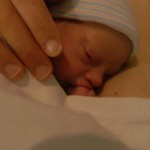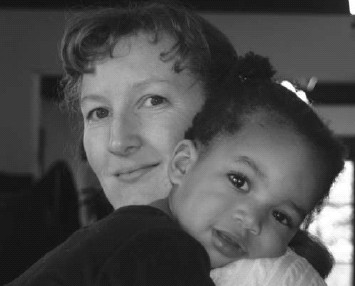By Kelly Coyle DiNorcia, API Leader. Originally published in the 2009 “New Baby” issue of Attached Family magazine

When I became pregnant with my daughter, I had every intention of having a “natural” childbirth. I wanted to labor at home without pain medication, to fully experience her entry into the world. I left my obstetrician’s practice and found a midwife whom I loved and who assured me that the birth I wanted was within my reach.
Of course, life does not always turn out the way we plan. Complications arose, necessitating interventions that eventually led to a Cesarean birth. The whole birth experience was traumatic, and I was angry and disappointed. I spent the first several months of motherhood feeling inadequate and depressed, and missed a lot of the joy that new babies can bring. After much reflection, I came to recognize my two biggest mistakes:
- I treated my pregnancy as an impending deadline—Instead of embracing the coming transition, I used those nine months to finish up projects. I was a student, I worked full time, and I was an active and dedicated volunteer –and all these things were important to me. I struggled with the idea that once I added “mother” to my list, something else would have to give because I wasn’t willing to sacrifice any of them. I insisted on plowing on … when I developed gestational diabetes, when I broke my foot in the seventh month of my pregnancy, when my feet swelled so much that I couldn’t put on shoes, when my blood pressure began to rise. I refused to stop and rest.
- I believed that my body would be permitted to give birth as it was built to do—It is certainly true that women are built, from a biological, physiological, anatomical and evolutionary perspective, to have offspring and that most of the time this can be done safely without intervention. However, what I did not realize was that the modern medical system is not designed to allow that to happen for most women, and that it can take a great deal of education, effort and willpower to fight for a natural birth. Most birth practitioners see birth not as a natural process but a necessity to be endured and sped through if possible, using whatever means are available to move things along. Avoiding this pitfall requires a great deal of preparation and soul-searching.
Deciding on VBAC
With this in mind, I began preparing for my Vaginal Birth After Cesarean (VBAC) within weeks of my first baby’s birth. I quizzed the surgeon about the location and orientation of my scar, the reasons for my daughter’s failure to descend and my chances for a future vaginal birth. He assured me that the surgery had gone well, and there was no reason I couldn’t attempt a VBAC. At the time, I didn’t know this was doctor-ese for “But your chances of success are about nil.”
I joined support groups. I read. I wrote in my journal. I entered therapy. I learned about the current medical model of obstetrics. I researched how I could take care of myself to prevent many of the complications I had experienced. I waited, and when the time was right, I became pregnant.
“By no means is it justifiable for anyone to be made to feel negatively about whatever birthing options they choose or for whatever birthing experience they have had. We all deserve to have our birthing choices and experiences validated.” Read more by Tamara Parnay in “The Importance of Sharing Birth Stories“
Unfortunately, my former midwife was no longer attending VBACs, so I was forced to start from square one and find a new provider. I was frustrated that I had to tell my story over and over and face so many negative reactions from providers who were pessimistic about my chances for success, but I came to realize that this was really a gift. I had the chance to start fresh, carefully consider my options and know that I had given myself the best chance for my desired outcome. I ended up going with the first midwives I interviewed – their VBAC success rate was very high, I felt instantly at ease with them, I liked their office and their hospital, and their backup doctors were incredibly supportive of natural birth and even collaborated with most of the homebirth midwives in my area.
I also asked a close friend of mine who is a doula to be with me during my birth. During my first pregnancy, I thought a support person was an unnecessary luxury, but this time, I knew better: having a woman there who was supportive and knowledgeable, and whose only responsibility was to help me through the process, was a necessity.
A Second Chance
I spent this pregnancy resting, eating well (when I wasn’t vomiting) and preparing myself and my family for the impending arrival of my son. I was able to avoid the medical complications of my previous pregnancy, I attended Bradley classes and when the time came, I was ready.
After a few false starts, labor started on a Friday at about 11:00 p.m. Unlike many of the videos I had seen of women giving birth surrounded by family and friends, I preferred darkness and solitude. While my family slept, I paced, showered, squatted, groaned and bounced. When daylight came, I called my midwife, doula and mother and then woke my family.
By the time I got to the hospital, I was 6 centimeters dilated and was having strong and regular contractions. We were given the room with the birth tub, which I was not able to use because there was meconium in the amniotic fluid, and I was allowed to use a fetal monitor that worked by telemetry so I could change position, walk and even shower.
I’m not really sure how long it took, but as darkness fell, the time had come to push. I walked around, squatted, laid on my back and side, and pushed for several hours. Eventually, I looked at my midwife and said, “Check.” But I knew that my baby hadn’t moved, that he was stuck high in the birth canal, that I was headed to the operating room again.
The nurses prepared me for surgery, the surgeon and anesthesiologist came in to introduce themselves, and my midwife helped my husband and friend pack all of our belongings as I struggled against the urge to push, waiting for an operating room to open up.
A little after 9:00 p.m. on Saturday, Harrison “Harry” Herbert Francis was born weighing 9 pounds, 1 ounce. He was healthy and robust, and the surgery went well. As soon as I was in recovery, my doula came in to check on us, and my midwife brought my son so I could nurse him, which he did easily and with gusto. He accompanied me to our room, where he stayed for our entire hospital stay.
Every Birth is Natural
When I met my first midwife, she had told me of her disdain for the term “natural childbirth.” She prefers the term “unmedicated childbirth,” because “natural” implies that there exists an unnatural way to give birth. However it happens for you, she said, is natural for you.
“Yeah, whatever,” I thought at the time, “be that as it may, I am going to give birth naturally, like our foremothers did, with no medication, no intervention, just me having a baby.”
Now, I know exactly what she meant. My second birth was not natural in the sense in which that term is commonly used, but I feel like it was as natural as possible under the circumstances.
I am still bitterly disappointed that I will probably never know what it is like to bring new life into the world on my own power, and I regret that I could not spend my children’s first moments of life snuggling and counting digits. Sometimes I feel like a marathon runner who fell within inches of the finish line and just … couldn’t …make… it … across. I hate that I am another statistic of a failed VBAC attempt and that I was unable to support other women for whom this opportunity is becoming increasingly scarce.
On the other hand, I am incredibly grateful to live in a time and place where the medical technology was available to bring my son and me safely through labor. I am empowered to know that I was strong and determined enough to at least make it to the finish line even if I couldn’t cross. And, of course, I am thankful for my two beautiful children. I won’t say that all the rest doesn’t matter as long as we are all healthy, because I believe that our birth stories do matter and that we are entitled to mourn the loss of the birth we wanted but couldn’t have. After all, whenever a baby is born, so is a mother. But in the end, I also believe that we all have the birth we need to make us better parents and people, and I am no less a woman or a mother because of the way my children came into the world.
To read more birth stories from our growing collection–or to find out how to share yours–visit Your Birth Stories on The Attached Family.com.



